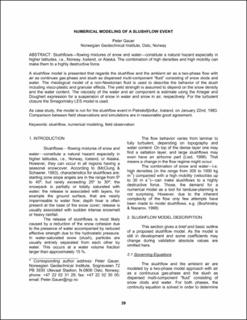| dc.description.abstract | Slushflows—flowing mixtures of snow and water—constitute a natural hazard especially in higher latitudes, i.e., Norway, Iceland, or Alaska. The combination of high densities and high mobility can make them to a highly destructive force. A slushflow model is presented that regards the slushflow and the ambient air as a two-phase flow with air as continues gas-phase and slush as dispersed multi-component “fluid” consisting of snow clods and water. The rheological model of a non-Newtonian fluid is used to describe the behavior of the slush including visco-plastic and granular effects. The yield strength is assumed to depend on the snow density and the water content. The viscosity of the water and air component is estimate using the Krieger and Doughert expression for a suspension of snow in water and snow in air, respectively. For the turbulent closure the Smagorinsky LES model is used. As case study, the model is run for the slushflow event in Patreksfjörđur, Iceland, on January 22nd, 1983. Comparison between field observations and simulations are in reasonable good agreement. | en_US |
